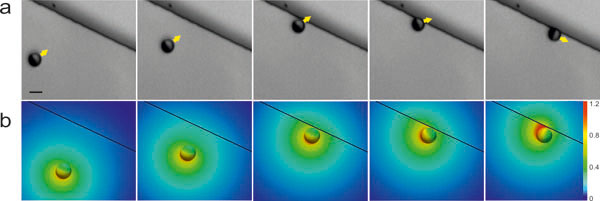This new study, the result of a collaboration between experimental research and theory, demonstrates that the particles can use the features of the surfaces over which they swim to change their direction of motion. “Micromotors tend to settle and move near surfaces, and we’ve seen that this tends to interfere with their swimming behaviour,” says group leader and ICREA research professor Samuel, who heads the Smart Nano-Bio-Devices group at IBEC and Stuttgart’s MPI-IS. “This led us to explore new methods to guide micromotors using surface alterations.”

Image, left: An active particle approaches a micro-fabricated step and orients along it due to chemical activity and hydrodynamic interactions. This phenomenon is exploited to guide the motion of the particles along tiny features on the surface.
Using a microfabrication process, the researchers modified surfaces to create a series of indentations or steps, several times smaller than the radius of the particle, which a specific type of micromotors – Janus particles, whose surfaces have two or more distinct physical properties – can use as signals to follow a particular path. This strategy is inspired by the one used by molecular motors in natural systems, where inside the cell, motor proteins bind to the cytoskeleton filaments to achieve directional motion.
The Janus particles are prepared by coating half of a silica particle with platinum. While the platinum face acts as a catalyst in hydrogen peroxide, the silica side remains inert, an asymmetry in chemical properties that leads to a self-propelled motion of these colloids. The researchers noticed that the particles tend to have a stable orientation parallel to the surface, and exploited this phenomenon to guide the particles along sub-micron sized steps. They were able to demonstrate that the chemical activity of the particles and the associated hydrodynamic interactions with the nearby surfaces are responsible for the observed phenomenon.
“This finding opens up the possibility of guiding these particles along complex pathways using small changes in the surface,” explains Samuel. “This can have significant implications for the design of new artificial micromotors for a variety of applications.”
—
Simmchen, J., Katuri, J., Uspal, W.E., Popescu, M.N., Tasinkevych, M., and Sánchez, S. (2016). Topographical pathways guide chemical microswimmers. Nat. Commun, 7, 10598
—
IBEC in the Media:





